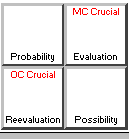Hello, everyone!
Does the storyform influence the character elements? Or are the elements of the characters independent of the storyform?
I have been using the Dramatica Pro Story Engine to learn dramatica. I wrote up an OS story outline with a concern of obtaining (basically an adventure story), and through it I had a faint intuition of the characters. Making some choices gave the MC problem as logic and solution as feeling. Same with the OS. No wonder this is the crucial element.
However, there are a few things that confuse me. The dramatica software still allows me to pick up the character elements independently of this storyform - is that possible? Shouldn’t one of the elements of the MC be locked on to logic?
Also, a related question - doesn’t this mean that use of the archetypes limits the number of storyforms we can work with?
And more on the overall intent here, how do I pick character elements if archetypes are not an option?

